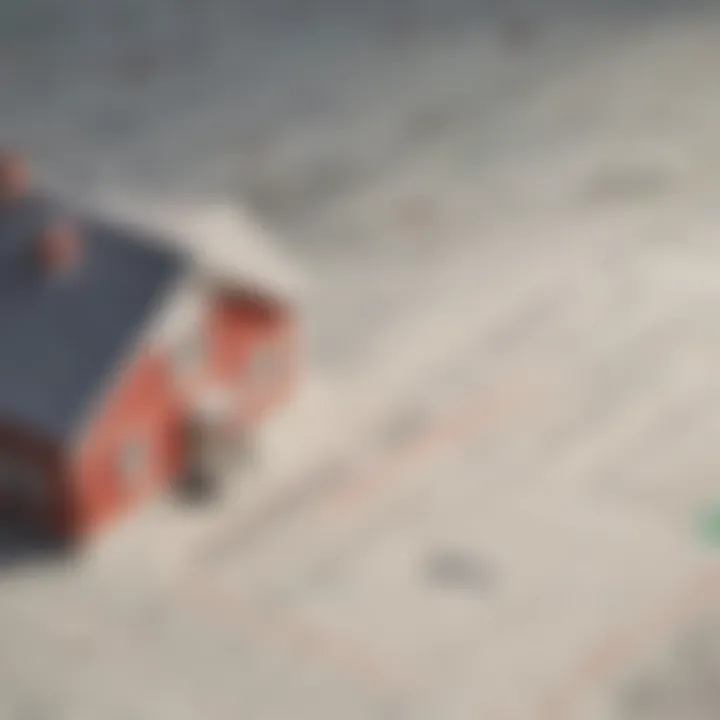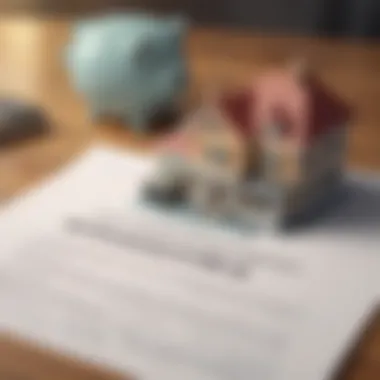Understanding the Best Down Payment for Your Home


Intro
Buying a home is one of the most significant financial decisions most people will make in their lives. An integral part of this decision is determining the optimal down payment. The down payment is not merely a figure; it serves as a pivot point for various financial elements, like mortgage rates and insurance costs. As prospective homeowners step into this arena, understanding its nuances can pave the path toward a sound investment.
Let's dive into the details and lay the groundwork for evaluating what kind of down payment might best suit your individual circumstances. In doing so, we'll consider not only the numbers but also the effects that varying amounts can have on overall mortgage commitments.
Investment Dictionaries
Common Financial Terms
To begin with, it's crucial to familiarize ourselves with some key financial terms that often emerge in conversations about home buying and down payments. This foundational understanding will assist in navigating deeper financial discussions.
- Down Payment: The initial upfront amount paid towards the purchase of a home, usually expressed as a percentage of the total purchase price.
- Mortgage Rate: The interest rate on a mortgage loan, which can greatly influence monthly payments and overall loan costs.
- Private Mortgage Insurance (PMI): Insurance that protects the lender in case the borrower defaults, often required when down payments are less than 20%.
- Equity: The portion of the home that the buyer owns outright, calculated as the difference between the home's market value and the remaining mortgage balance.
Advanced Investment Terminology
When venturing further into the real estate investment landscape, certain terms will enhance your conversations:
- Leverage: Using borrowed capital for investment, which can amplify both returns and risks.
- Amortization: The process of spreading out a loan into a series of fixed payments over time, affecting how much equity is built over the years.
- Points: Fees paid to reduce the mortgage rate, typically measured as a percentage of the loan amount.
Understanding these terms can significantly alter the perception of financial scenarios and lead to more informed choices when it comes to down payments and mortgage options.
"A larger down payment can mean lower monthly payments, but buyer circumstances will vary greatly."
Expert Advice
Tailored Investment Strategies
Next, let’s explore tailored investment strategies that make a meaningful difference in determining your down payment:
- Assess Personal Financial Situation: Every buyer's financial landscape is different. Evaluate income, debts, and savings to find a comfortable down payment percentage.
- Market Research: Investigate local market conditions. A hot market might lean towards a higher percentage to remain competitive, while a slower market could provide leverage for a lower payment.
- Future Planning: Factor in future life events. Whether it's a job change or family planning, these can significantly impact your financial readiness.
Risk Management Techniques
Equally as important are the strategies for managing risk:
- Diversification: Don’t put all your financial eggs in one basket. Ensure you maintain savings or investments outside of your home.
- Evaluate Loan Terms: Analyze your mortgage responsibly. A longer term may lower payments, but pay attention to the interest paid over time.
- Understanding Market Trends: Stay updated on economic conditions that can affect housing prices. This awareness can help guide your down payment timing.
Navigating the terrain of home buying requires understanding, adaptability, and awareness of personal and market dynamics. With the right strategies in place, potential homeowners can make well-informed decisions that align with their long-term financial goals.
Defining Down Payment
When it comes to home buying, understanding the concept of a down payment can significantly influence your financial trajectory. This section will unpack essential aspects of what a down payment entails, and how it plays a vital role in the home purchasing process. A down payment is essentially an initial upfront payment made towards the purchase of a property, expressed as a percentage of the total purchase price.
For instance, if you are looking to buy a house priced at $300,000, a 20% down payment would mean you put down $60,000 initially. This initial investment is not just a formality; it directly impacts your mortgage terms, interest rates, and even your ability to secure financing.
Concept of Down Payment
In simple terms, the concept of a down payment reflects the buyer's commitment to the purchase. A higher down payment often signals to lenders that the buyer is less risky, as they are financially invested in the property right from the start. The amount of your down payment is usually dictated by various factors, including your financial situation, savings, and lender requirements.
When you think about this in a practical sense, it’s like showing up to a poker game with a hefty stack of chips. The more you invest upfront, the more serious your intentions appear, and the better leverage you might have in negotiations. Beyond just securing financing, the size of your down payment plays a pivotal role in shaping your monthly mortgage payments. Consequently, it can affect home equity build-up and overall financial health.
In recent times, the rise of flexible mortgage options has added layers to how buyers approach the down payment. While conventional wisdom dictates that 20% is the sweet spot, many buyers now consider lower percentages without compromising their financial goals.
Importance of Down Payment
Understanding the importance of a down payment goes beyond traditional views of home-buying; it touches on your financial stability and future investment potential. First and foremost, a sizable down payment reduces the principal amount you are borrowing from the bank, which leads to lower monthly mortgage payments. This can free up cash for other expenses, enhancing your budget flexibility.
Moreover, larger down payments often mean lower interest rates. When lenders see that you are financially capable of making a bigger initial investment, they typically view you as less of a risk. This reduced risk could ultimately save you thousands in interest payments over the life of your loan.
Another crucial aspect is that the down payment helps you bypass private mortgage insurance (PMI), which can add to your monthly costs if your down payment is less than 20%. In this way, a solid down payment can lead to greater home equity sooner, allowing you to leverage that equity for future investments or financial needs.
"A larger exit at the start can lead to more substantial gains down the line."


Additionally, for those contemplating selling or refinancing in the future, having a larger down payment means greater equity in the home. This could be beneficial in a sale transaction or even when negotiating better terms for a subsequent loan down the line. Consider this: if housing market trends are favorable, your initial investment can quickly escalate in value, giving you not only a place to live but a significant asset.
In summary, grasping the concept and significance of a down payment is a cornerstone of making informed decisions in the housing market. It’s a balancing act of personal finance, risk, and opportunity that every homebuyer must navigate.
Standard Down Payment Percentages
Understanding the varying down payment percentages is crucial for anyone stepping into the complex world of home buying. One size doesn’t fit all when it comes to how much cash to put down. This section will help detail what the standard percentages are, which options might suit different buyers, and why these choices matter. By diving into these down payment options, we’ll shed light on how they interact with everything from mortgage rates to overall financial health.
Conventional Options
For many first-time buyers, leveraging conventional loan options can be an appealing pathway. Generally, a conventional loan can require a down payment as low as 3%, but when buyers opt for a lower down payment, they may face tighter eligibility criteria and potentially higher rates.
- Benefits of Lower Down Payments: A smaller down payment means reduced upfront costs, allowing buyers to conserve cash for moving expenses or renovations. Since saving for 20% of your dream home’s cost can feel like a marathon, going conventional is sometimes the light at the end of the tunnel.
- Considerations: But it isn’t all sunshine and roses. Lower down payments typically mean higher monthly mortgage payments and possibly Private Mortgage Insurance (PMI), which protects the lender if you default. So, while you might stretch your dollars further today, the long-term picture needs evaluating closely.
FHA Loans
Now, let’s turn the focus to FHA loans. The Federal Housing Administration (FHA) caters to buyers who fit a specific profile and includes very attractive down payment options. One of the startling highlights is that FHA loans can allow as little as 3.5% down.
- Accessibility: This program is particularly alluring for those with a less-than-stellar credit score. It opens doors for many who might otherwise feel shut out of the housing market.
- Limitations: However, not everything sparkles like a new penny. FHA loans come with their own hurdles, such as mortgage insurance premiums that can linger for the life of the loan if the down payment is less than 10%. Thus, buyers need to weigh the initial affordability against long-term costs.
VA and USDA Loans
If you’re a veteran or planning to buy in a rural area, you may consider VA or USDA loans. They have unique charm points that set them apart.
- VA Loans: Well known among veterans, these loans often require no down payment whatsoever. This can be a game changer, allowing those who served the country to purchase homes without that heavy financial burden.
- USDA Loans: For buyers eyeing rural areas, USDA loans offer the same allure, with no down payment requirement as well. Both options require meeting specific eligibility criteria. They tend to prioritize lower-income buyers, essentially helping to spur growth in less populated areas.
To wrap up this section, understanding these standard down payment percentages enables buyers to play their cards right. Whether going conventional, exploring FHA, or taking advantage of VA and USDA loans, knowing the terrain can lead to better-informed decisions—nobody wants to find themselves snatching at their wallets down the line.
Factors Influencing Down Payment Decisions
When it comes to buying a house, the down payment isn't just a number; it's a signal of your financial strategy and readiness for homeownership. Multiple factors come into play when deciding how much to put down. It's crucial to understand these elements, as they can substantially impact your mortgage terms, monthly payments, and overall financial health. Here, we delve deeper into the various influences that can shape your down payment decision.
Personal Financial Situation
Credit Score
Your credit score stands as a beacon of your financial reliability. Lenders use this number to gauge risk when considering your mortgage application. Generally, a higher score often opens the door to better interest rates and more favorable loan terms. Many borrowers aim for a credit score of at least 620, but aiming higher can further enhance your options. A solid score reflects timely payments on debts and responsible credit use.
However, if your score is on the lower end, you'll likely find yourself facing additional hurdles, such as higher interest rates or even the necessity for private mortgage insurance. It’s a double-edged sword; while a poor credit history can limit your options, improving your score often leads to lower monthly payments in the long run.
Debt-to-Income Ratio
The debt-to-income (DTI) ratio is pivotal in determining how much mortgage you can afford. It compares your monthly debt payments to your gross monthly income. A lower DTI usually indicates a better capacity to handle new debt, which appeals to lenders. Most recommend keeping your DTI below 36%, but some have more lenient guidelines.
Notably, this ratio also captures your overall financial landscape. A high DTI can limit your home-buying power, as lenders may worry about your ability to make monthly payments. So, if you find yourself juggling multiple debts, it might be wise to lighten your financial load before taking the plunge into homeownership.
Cash Reserves
Cash reserves refer to the funds you have set aside for unforeseen expenses or emergencies. Lenders look favorably upon applicants with a healthy cushion, as it reduces their risk. Having savings available can mean the difference between being able to afford a home or being turned down for a mortgage altogether.
It’s important to note that reserves go beyond the down payment; they provide a safety net for things like closing costs, inspections, or even repairs after purchase. A generous reserve fund ensures you're not just scraping by post-purchase, and aids in mitigating risks that come with homeownership.
Market Conditions
Local Real Estate Trends
Market conditions can fluctuate wildly based on local trends. In a hot market, you may face fierce competition and rising home prices, making it even more crucial to secure an optimal down payment. Sellers may favor buyers with larger cash reserves upfront, seeing them as serious contenders.
Furthermore, understanding local trends can aid in making informed decisions about how much you're willing to put down. If the market is booming and homes are selling over asking price, perhaps a higher down payment would not only strengthen your offer but also ease monthly financial pressures.
Interest Rates
Interest rates form the bedrock of your mortgage's overall cost. When rates are low, it’s often tempting to put down a smaller sum and invest the remainder elsewhere. On the flip side, higher rates could push you to save more to lower your monthly payments.
The background influence of interest rates also shapes the overall economic landscape. They can sway market trends and even your long-term financial stability. Keeping tabs on rate shifts can help you gauge when to act, ensuring you strike when the iron's hot.


Investment Goals
Long-Term vs Short-Term
Your investment strategy plays a significant role in determining your down payment. For instance, if you plan to stay in a home long-term, a higher down payment can lower your monthly payments, leading to less financial stress over time. Conversely, if you're looking at the property as a short-term investment or a flip, you might prefer to keep your cash available for renovations or quick selling.
The key is understanding your goals; are you in it for the long haul or just passing through? Your approach will undoubtedly influence your down payment choices.
Rental Income Potential
If you're considering purchasing a property as an investment for rental income, the down payment you choose must take into account potential cash flow. A larger down payment may acquire more favorable loan terms, whereas a smaller one can leave you with less equity but potentially more cash flow to invest in multiple properties.
Yet, it's a balancing act. Knowing the rental market, understanding operating expenses, and assessing the property's future value all need to feature in your decision-making process. The broader the perspective, the better the down payment decision will be.
Economic Implications of Down Payments
When contemplating homeownership, especially for first-time buyers, the economic implications of down payments play a crucial role. This section delves deep into how the initial monetary commitment influences future financial obligations, giving potential homeowners clarity on why it matters.
Cost of Mortgages
The amount you put down affects the overall cost of the mortgage. Generally, a larger down payment leads to a lower loan amount, which means less interest paid over time. Imagine securing a house listed for $300,000. If you opt to put down 20%, that’s a $60,000 deduction from your principal, lowering your loan to $240,000. It might feel like a hefty sum upfront, but the ripple effects on monthly payments and total interest over the life of the loan are significant. A smaller down payment, such as 3%, leaves you with a much larger principal.
- Higher Monthly Payments: A bigger loan results in higher monthly repayments. If you aren't careful, that could stretch your budget thin.
- Longer Loan Term: With a larger sum to repay, some homeowners might settle for a 30-year term, resulting in years of interest payments.
- Total Interest Costs: Depending on interest rates, a smaller down payment could end up costing you tens of thousands more due to interest accrued over the mortgage term.
It is easy to see how a seemingly small decision can turn into substantial financial burdens down the road. The difference between $240,000 and $300,000 can impact your lifestyle long after you’ve signed the dotted line.
Private Mortgage Insurance
Let’s discuss Private Mortgage Insurance (PMI). When buyers can’t manage that 20% down payment, lenders often require PMI. This insurance offers protection to the lender, in case you default on the loan. While this may initially seem like a safety net, it adds another layer of expense to your monthly payment.
Here are some key takeaways about PMI:
- Added Cost: PMI can range from 0.3% to 1.5% of the original loan amount annually. For a $300,000 home, this can mean an extra $1,000 to $4,500 per year.
- Duration of PMI: Many assume it’s a one-time fee, but PMI can stick around until you hit 20% equity in your home. This can delay financial freedom for years.
- Alternatives: Some lenders offer low-down-payment options without PMI. However, these often come with high-interest rates or non-standard terms.
PMI may seem like a pathway to homeownership for those without the means for a large down payment, but it can be a sneaky financial burden.
End
Understanding the economic implications of down payments isn’t just about numbers—it’s about long-term impacts on financial wellness. Assessing both the costs of mortgages and the added weight of Private Mortgage Insurance can illuminate a path.
Consider your circumstances carefully. A well-placed down payment can set you on a promising trajectory, while a poor decision could lead you down a financially strained road. By getting a grip on these nuances, homebuyers can navigate their choices with greater wisdom.
Optimal Down Payment Recommendations
When it comes to navigating the complex world of home buying, understanding the nuances of down payments can make a world of difference. Optimal down payment recommendations help buyers strike a balance between affordability, equity, and financial flexibility. It's not just about a number on a checklist; it's about crafting a strategy that aligns with personal goals and market realities. This section outlines crucial standard recommendations and some alternative strategies that could better suit different circumstances.
Standard Recommendations
In conventional wisdom, many first-time home buyers are discouraged from considering anything less than a 20% down payment. While this figure originated from a time when lenders primarily focused on minimizing their risk, it often creates unnecessary limitations for buyers. Nonetheless, aiming for 20% does come with certain benefits:
- Avoiding Private Mortgage Insurance (PMI): Making a 20% down payment often eliminates the need for PMI, which can add a hefty amount to monthly mortgage payments, sometimes adding hundreds of dollars annually.
- Lower Monthly Payments: A higher initial payment reduces the overall loan amount, leading to lower monthly obligations. For instance, a $300,000 house with a 20% down payment translates to a loan of $240,000 compared to $270,000 with a mere 10% down.
- More Equity from the Start: Put simply, more cash upfront means you own more of your house right off the bat, which can provide better leverage for future financing needs.
However, it’s essential to recognize that the 20% standard isn't a one-size-fits-all solution.
Factors like personal financial situations, property types, and the local housing market may necessitate a different approach. For those focused on other investments or experiencing personal liquidity challenges, a lower percentage may well be advisable.
Alternative Strategies
While conventional recommendations suggest aiming for a 20% down payment, various alternatives can cater to specific financial scenarios.
- FHA Loans: For buyers with less-than-stellar credit or lower savings, an FHA loan can be a game-changer, allowing as little as 3.5% down. This route enables potential homeowners to enter the market sooner rather than later.
- VA and USDA Loans: For veterans or eligible rural property buyers, these loans offer no down payment options, which can drastically alter financial approaches for qualified applicants.
- Piggyback Loans: This strategy involves taking out a second mortgage to assist with the down payment. For instance, a buyer could place 10% down on one mortgage and secure a second that covers another 10%.
- Pros: Lower barrier to entry, flexibility in credit scores.
- Cons: Requires mortgage insurance premiums, both upfront and ongoing.
- Pros: Minuscule upfront costs, no PMI.
- Cons: Strict eligibility criteria.


- Pros: Allows more flexibility in budget, reduces PMI.
- Cons: Higher overall debt and complexity in financing.
Important to Note: Not all lenders are willing to engage in piggyback loans, so it’s wise to shop around.
- Saving for a Larger Down Payment: If feasible, delaying home purchase while saving more may provide a stronger financial position, including better interest rates and overall loan terms.
Ultimately, the overarching goal of any down payment strategy should reflect individual circumstances, balancing immediate financial impact against long-term investment goals.
Common Myths About Down Payments
Understanding down payments can be a bit like navigating a maze. There are many twists and turns, with myths growing like weeds in a garden. These misconceptions can lead buyers astray, affecting their financial choices. Recognizing the truth behind these myths is crucial for anyone looking to purchase a home. Getting a clear picture can save you both time and money. This section delves into two common myths, aiming to shed light on them.
Myth of the % Down Payment
A prevalent belief is that a home buyer must put down 20% of the home's purchase price. Many cling to this idea as if it were gospel truth, thinking it’s the golden rule. Yes, putting down 20% can eliminate Private Mortgage Insurance, or PMI, and may lead to better loan terms, but it’s not a one-size-fits-all situation.
- Budgeting: First-time buyers may find it hard to save that hefty amount while juggling rent, bills, and other expenses. This myth often discourages would-be homeowners from even starting the journey.
- Flexibility: Options like FHA loans require as little as 3.5% down, while VA loans allow qualified veterans to buy without any down payment. This means that many buyers can still secure a mortgage and purchase a home without breaking the bank.
"You don’t have to empty your pockets to step onto the property ladder!"
In a world where housing prices can skyrocket, it’s essential to grasp that a lower down payment doesn’t equate to a lower commitment to home ownership. The notion of needing 20% can hinder people from making significant investments in their future.
Misconceptions About PMI
Another myth that circulates in real estate conversations is the negative perception of PMI. People often think that PMI is just another unnecessary hurdle. Sure, PMI means additional costs; however, it is also a gateway for many to home ownership.
- Cost Considerations: The cost of PMI can vary, typically running between 0.3% to 1.5% of the original loan amount annually. Buyers may mistakenly think this is a permanent fee. In fact, once you build a significant equity in your home, around 20%, you can often have the PMI removed, which mitigates its perceived disadvantages.
- Access to Opportunities: PMI opens doors that might otherwise be closed. By allowing buyers to make smaller down payments, it makes home owning attainable. For many, this can mean the difference between being a renter and a proud homeowner.
In summary, being informed about these myths surrounding down payments can empower buyers to make better financial choices. The road to home ownership is filled with a range of options, and being aware of these facts could very well change the trajectory of one’s housing journey.
Evaluating Your Financial Readiness
Determining the right down payment for your home is a pivotal leap into property ownership. However, before you even start counting pennies, it’s essential to gauge your financial readiness. This phase is more than just having enough cash in your pocket; it involves a slew of factors that dictate not only how much you can afford to put down, but also the long-term sustainability of your investment. Ignoring these elements can lead to a financial mess, so it’s wise to approach this stage thoroughly.
Creating a Financial Plan
A well-constructed financial plan is like creating a roadmap before embarking on a journey. Without one, you may find yourself wandering aimlessly, perhaps even hitting some unexpected bumps along the way. Here’s how to lay it out:
- Assess Your Current Financial Landscape
Begin by listing all your income sources, monthly expenses, and debts. This gives you a snapshot of your financial health. You’ll want to calculate your debt-to-income ratio. Ideally, this should hover around 36% or lower. A higher ratio may imply you're stretching your finances too thin. - Establish Down Payment Goals
Based on your financial situation, set a realistic down payment goal. Conventional wisdom often suggests 20%, but if it feels daunting, consider lower percentages achieved through FHA or VA loans. - Create a Savings Timeline
Once you have your goals in place, draft a timeline for how you plan to save toward that down payment. Break it down into monthly or bi-weekly targets. Having this structure keeps you accountable and motivated. - Consider Additional Costs
Don't lose sight of the overall picture. Home ownership is laden with ongoing expenses: closing costs, property taxes, and maintenance. Including these costs in your budget will help avoid unpleasant surprises later on.
It's crucial to not only focus on the down payment but also on the overall financial responsibility that home ownership entails.
- Consult a Financial Advisor
If the numbers feel overwhelming, getting some professional advice may be beneficial. A financial advisor can offer insights tailored to your specific situation, making the path to home ownership clearer.
Assessing Risk Tolerance
Assessing your risk tolerance is another fundamental piece of the puzzle. Your risk tolerance is determined by how comfortable you are with potential financial loss or market fluctuations. This aspect can influence your down payment decision significantly.
- Evaluate Market Conditions
If you're looking at a hot real estate market, you might feel pressure to put down a larger amount to secure a property. Conversely, in a sluggish market, lower down payments might make more sense. - Personal Comfort Level
Ask yourself: "How would I feel if I lost some of my investment?" Understanding your reaction to loss can help establish how much you’re willing to put at risk. - Consider Investment Goals
Your strategies around property investment—be it rental income, resale value, or both—can dictate your comfort with risk. Aligning your risk tolerance with your long-term goals is essential. If your aim is a quick resale, a larger down payment might be beneficial. - Prepare for the Unexpected
Life is unpredictable. Building an emergency fund on top of your down payment can cushion any future financial hits. This assures you won’t be caught off guard and potentially compromise your investment.
Understanding your financial readiness is not just about having enough saved up; it's about painting a comprehensive picture of your financial landscape, your comfort with risk, and strategizing effectively to achieve your dream of home ownership.
Epilogue
In today's market, the choice of down payment should reflect both the current economic conditions and personal financial situations. Buyers must balance their upfront investment with long-term goals, including how they plan to leverage the property in the future.
"A thoughtful choice of down payment can be your panacea in navigating housing market intricacies."
Summary of Insights
Reflecting on the insights revealed throughout this article, several fundamental points emerge:
- Personal Financial Analysis: Know your credit score, debt-to-income ratio, and liquid assets before diving into mortgage options.
- Market Trends: Stay updated on local real estate trends and interest rates, as they directly affect the feasibility of various down payment amounts.
- Investment Horizon: Understand the implications of short-term vs long-term ownership, especially in relation to potential rental income and property value appreciation.
By integrating these insights into your decision-making process, you can avoid common pitfalls and maximize your real estate investments.
Final Thoughts on Down Payments
As the adage goes, "measure twice, cut once." This holds especially true when it comes to down payments. Taking the time to research and understand your options will serve you well as you embark on the journey of homeownership. Consider not just the immediate impact on your finances but also the broader implications for your lifestyle and investment portfolio.
Ultimately, the ideal down payment is a blend of personal finance strategy, market knowledge, and clear investment goals. It's not a one-size-fits-all scenario. Whatever path you choose, being well-informed and deliberate can help you make the best decision for your unique circumstances.







